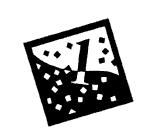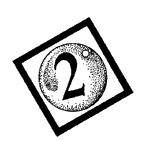|
Several books featuring buttons are included to accompany the
sorting and classifying activities in the first three sessions
that involve buttons. The other sessions use plastic frogs for
a variety of activities that involve estimation, counting, organizing
data, logical thinking skills, probability
and statistics. There are books listed on several of those topics
though many more can be found. In addition, this list includes
a variety of books on frogs from storybooks to inviting informational
books.
Alligator Shoes
The Button Box
A Chair For My Mother
Corduroy
Count & Find 100 Frogs & 10 Flies
The Frog
The Frog Alphabet Book
Frog and Toad Are Friends
How Much Is A Million?
It’s Mine!
Jumanji
Kimako’s Story
The Magic Bubble Trip
The Stupids Die
Tuesday
Whose Hat Is That?
The Yellow Button
Alligator Shoes
by Arthur Dorros
E.P. Dutton, New York. 1982
Grades: Preschool–K
Being locked in a shoe store by mistake is Alvin alligator’s
dream come true. He tries on an endless variety of footwear, but
his decision about what footgear he prefers will surprise and
delight your students. Great to read before having students use
their own shoes to sort and use as the data for a real-life graph.
Ties in with Session 2: Sort, Classify and “Guess the Sort.”
Return to title list.
The Button Box
by Margarette S. Reid; illustrated by Sarah Chamberlain
Dutton’s Children’s Books, New York. 1992
Grades: Preschool–2
As a young child explores and examines the buttons in his
Grandma’s special button box, he sorts and classifies the
buttons. Many attributes of buttons are illustrated including
color and size, materials from which buttons are made, and buttons
for different articles of clothing. This serves as a great introduction
to Session 2. In The Button Box, buttons are also used
to make a toy and create eyes on a puppet. A brief history of
buttons for adults is included.
Return to title list.
A Chair For My Mother
by Vera B. Williams
Greenwillow Books/William Morrow, New York. 1982
Grades: K–3
A child, her waitress mother, and her grandmother save coins
to buy a comfortable armchair after all their furniture is lost
in a fire. The accumulation of coins of various denominations
in a jar grows to a significant amount and is exchanged for dollars
at the bank. Ties in with estimation activities in Session 4.
Consider also Vera Williams' other books—Something Special
For Me and Music, Music for Everyone. All the stories
involve the money jar.
Return to title list.
Corduroy
by Don Freeman
Viking Press, New York. 1968
Grades: Preschool–2
Corduroy, an adventurous teddy bear, explores his department
store home one night in search of a button lost from his overalls.
After he is returned to the toy display, an African-American girl
named Lisa buys him with the pennies that she has saved and sews
a new button on his overalls as soon as she gets him home. Nice
connection to the lost button discussion and the button sorting
and classifying activities in Frog Math.
Return to title list.
Count & Find 100 Frogs & 10
Flies
by Polly Jordan
McClanahan Book Company, New York. 1992
Out of print
Grades: Preschool–2
Count by tens all the way to one hundred with this delightful,
whimsical frog counting book. Added attraction is a hidden fly
to find on each page. Ties in with Session 4: Frog Guesstimation.
Return to title list.
The Frog
by Angela Royston; illustrated by Bernard Robinson
Ideals Children’s Books, Nashville, Tennessee. 1989
Grades: K–3
The life cycle of a frog through the seasons, beginning with
mating in spring, is explained. Predator and prey relationships
among animals in a pond habitat are illustrated. A small glossary
and scientific information on frogs are provided. A good sampling
of the diversity of frogs around the world.
Return to title list.
The Frog Alphabet Book
by Jerry Pallotta; illustrated by Ralph Masiello
Charlesbridge Publishing, Watertown, Massachusetts. 1990
Grades: K–3
A beautifully illustrated book that shows the diversity of
frogs and other “awesome amphibians” from around the
world.
Return to title list.
Frog and Toad Are Friends
by Arnold Lobel
Harper & Row, New York. 1970
Grades: K–2
This well-known collection of stories provides the “jumping
off place” for Frog Math activities. The story “A Lost
Button” begins the button sorting and classification session
and “The Swim” is often read with the “Hop to the
Pond” game. The entire book is a strong example of how mathematics
and literature can be “leapfrogged” together in fun
and stimulating ways.
Return to title list.
How Much Is A Million?
by David M. Schwartz; illustrated by Steven Kellogg
Lothrop, Lee & Shepard Books, New York. 1985
Grades: K–5
With detailed, whimsical illustrations that include children,
goldfish, and stars, this book leads the reader to conceptualize
what at first seems inconceivable—a million, a billion, and
a trillion. Gives young children as concrete a representation
of large numbers as possible. An adult-level explanation to calculate
the numbers is included. Ties in with Session 4: Frog Guesstimation.
Return to title list.
It’s Mine!
by Leo Lionni
Alfred A. Knopf, New York. 1985
Grades: K–2
Three selfish frogs quarrel over who owns their pond and island
until a storm makes them value the benefits of sharing. As children
work as partners in many of the activities in Frog Math,
the delightful frog friends in this book can be used to illustrate
the benefits of the cooperative spirit.
Return to title list.
Jumanji
by Chris Van Allsburg
Houghton Mifflin, Boston. 1981
Scholastic, New York. 1988
Grades: 3–Adult
A bored brother and sister left on their own find a discarded
board game (called Jumanji), which turns their home into an exotic
jungle. A final roll of the dice for two sixes helps them escape
from an erupting volcano. Goes along well with Session 6: Hop
to the Pond Game with 12 frogs racing to the pond.
Return to title list.
Kimako’s Story
by June Jordan; illustrated by Kay Burford
Houghton Mifflin, Boston. 1981
Grades: 2–3
A little girl works poetry puzzles indoors and has outdoor
adventures with a dog. The story includes poem puzzles for the
reader to complete and a map of Kimako’s city paths. Promotes
logical-thinking skills.
Return to title list.
The Magic Bubble Trip
by Ingrid & Dieter Schubert
Kane/Miller Book Publishers, New York. 1981
Grades: K–3
James blows a giant bubble that carries him away to a land
of large hairy frogs where he has a fun, fanciful adventure.
Return to title list.
The Stupids Die
by Harry Allard and James Marshall
Houghton Mifflin, Boston. 1981
Grades: K–3
This book about the Stupid family—along with The Stupids
Step Out and The Stupids Have a Ball—has children
laughing with delight as they see the Stupid children do such
silly things as slide up a banister or take a bath fully clothed
in an empty bath tub. These books promote logical-thinking skills
as kids find all the outrageous things and suggest ways to correct
them. Ties in with Session 5, as logical thinking helps catch
the magic frog!
Return to title list.
Tuesday
by David Wiesner
Clarion Books, New York. 1991
Grades: K–Adult
Frogs rise on their lily pads, float through the air, and
explore the nearby houses while the inhabitants sleep in this
beautifully illustrated and almost wordless book.
Return to title list.
Whose Hat Is That?
by Ron Roy; photographs by Rosemarie Hausherr
Clarion Books/Ticknor and Fields, New York. 1987
Grades: Preschool–2
Text and photographs portray the appearance and function of
eighteen types of hats including a top hat, a jockey’s cap,
and a football helmet. The children and adults modeling the hats
represent a rainbow of peoples. Makes a nice connection to classification
activities in Session 2: Sort, Classify and “Guess the Sort.”
Children can bring in hats and sort them! His other book, Whose
Shoes Are These?, shows nineteen different types of shoes
and works equally well with the same session.
Return to title list.
The Yellow Button
by Anne Mazer; illustrated by Judy Pedersen
Alfred A. Knopf, New York. 1990
Grades: K–8
There is a button in a pocket, worn by a girl, lying on a
couch, in a living room, in a house, at the edge of a field, near
a mountain range, in a country, on a planet, in a universe. This
book communicates the relationship of small to big in a very simple
fashion.
Return to title list.
|



|



